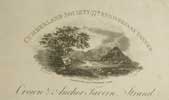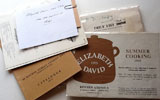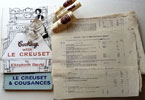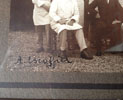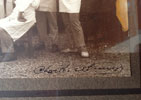ANON.
- A rare dinner invitation to the London Tavern, Bishopsgate St. 1857.
LINEN DRAPERS SILK MERCHANTS
LACEMENS' HABERDASHERS' AND HOSIERS' INSTITUTION. THE TWENTY-FIFTH ANNIVERSARY DINNER, AT THE London Tavern, Bishopsgate Street, on Tuesday, February 24th, 1857. SIR JOHN VILLIERS SHELLEY, BART., M.P., IN THE CHAIR. STEWARDS: Mr. FREDRK. ARMFIELD - Mr. JOHN ALLAN - Mr. JOHN FIVEASH - Mr. JOHN GEB - Mr. JOHN JARVIS - Mr. ROBERT MINTON - Mr. OSBORN - Mr. THOS. RUSSELL - Mr. W. RUTTY - Mr. J. RABBIDGE - Mr. JAMES ROBBINS - Mr. JOHN SCOTT - Mr. G.F. WALLIS. The Musical Arrangements under the management of Mr. Lawler, assisted by Miss Poole, Miss B. Palmer, and others. This Ticket will admit Mr. ------------ Dinner on Table at Six o'Clock, exact time. --TICKETS, including Wine, ONe Guinea. NO. 435. GEORGE BRACE, Secretary, 24, Surry Street, Strand. Tickets not returned to the secretary on or before the 20th of February, to be paid for.
115x150mm. Cream coloured card with black, red and green coloured text. Nice clean condition.
-
Bishopsgate Street was anciently divided into Bishopsgate Street Within (i.e. within the walls of London) and Bishopsgate Street Without, and derives its name after one of the original seven gates in London Wall. The foundation of the original gate is attributed to Erkenwald, elected Bishop of London in 675. Henry III granted the gate (which would have contained buildings above and beside it) to the Hanse merchants, who substantially rebuilt the gate in 1479: the gate was adorned with statues of past bishops of London.
It was declared an obstruction to traffic in the eighteenth century and subsequently demolished.
Bishopsgate Street Within contained three churches, St Martin Outreach, St Ethelburga, and St Helen, and the famous Crosby Hall as well as the London Tavern, used for many public meetings, banquets and dinners.
Bishopsgate Street Without was wider and longer than Within, and during medieval times many pleasure gardens and bowling alleys ran off it.
Throughout most of its history Bishopsgate Street has been one of the City's main commercial streets, and has housed many fine mansions of the nobility, of whom many were entertained by the plays performed at the Bull Inn, a famous playhouse of Elizabethan times. Afterward they would have dined at the nearby London Tavern, one of the best known and most prestigious city venues.
See print #2 below for an image of a small salon inside the London Tavern.






|
|

Ephemera category
ref number:
11105
|



